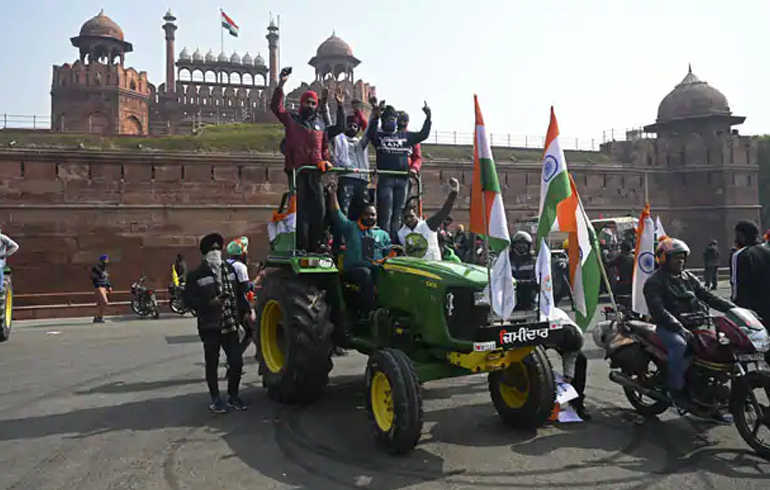Thousands of farmers protesting at agriculture reforms have fought through police barricades and tear gas to enter Delhi’s historic Red Fort complex.
They are on foot and in tractors – part of a massive rally that was planned to coincide with India’s Republic Day.
Many protesters diverted from agreed routes and clashes broke out with police. One protester has died.
The government says the reforms will liberalise the agriculture sector but farmers say they will lose income.
Tens of thousands of them have been striking on the outskirts of Delhi since November, demanding the laws be repealed. They rejected a government offer to put the laws on hold last week.

Police agreed to allow Tuesday’s rally after several rounds of talks on the condition that it would not interrupt the annual Republic Day parade, which takes place in central Delhi. They gave farmers specific routes for their rally, which would largely be confined to the outskirts.
But farmers instead converged on the iconic 16th Century fortress. They breached security and clambered onto the walls and domes of the fort, even hoisting flags alongside the national flag.
While farmers at several entry points appear to have followed the agreed routes, a section of protesters at the Ghazipur, Sinnghu and Tikri borders, three of the six main entry points to the city, broke through police barricades earlier in the day
Those at Ghazipur started marching towards central Delhi, where India’s parliament is located.

“Mr Modi will have to take back these black laws for sure,” one protester told the BBC’s Salman Ravi.
Images from the ITO metro station junction – which is on the route to central Delhi – showed police clashing with protesting farmers and using tear gas and batons against them. Protesters driving tractors appeared to be deliberately trying to run over police personnel. Local media reported injuries on both sides.
At least one protester died at the junction when his tractor overturned as police fired tear gas.
BBC correspondents say protesters outnumber the police at the ITO junction, and the latter are struggling to control the crowd.

The annual parade involves armed forces showcasing their latest equipment and floats from several states presenting their culture on a national stage. The parade is shorter and more muted this year due to the pandemic.
The laws, which seek to further open up agriculture to the free market, sparked protests even as they made their way through parliament in September. While Prime Minister Narendra Modi and his Bharatiya Janata Party-led government defended the reforms, farmer groups likened them to a “death warrant” that made them vulnerable to private companies.
The stand-off continued as tens of thousands of farmers from the northern states of Punjab and Haryana marched to Delhi in late November and began sit-ins at the city limits, many of which still continue.


What exactly do the laws propose?
Taken together, the laws loosen rules around the sale, pricing and storage of farm produce – rules that have protected India’s farmers from the free market for decades.
One of the biggest changes is that farmers will be allowed to sell their produce at a market price directly to private players – agricultural businesses, supermarket chains and online grocers.
More than 90% of India’s farmers already sell their produce in the market – and only about 6% of them actually receive assured prices for their crops, guaranteed by the government.

But farmers are mainly concerned that this will eventually lead to the end of government-controlled wholesale markets (mandis) and assured prices, leaving them with no back-up option. That is, if they are not satisfied with the price offered by a private buyer, they cannot return to the mandi or use it as a bargaining chip during negotiations.
Most of the protesting farmers are from Punjab and Haryana, where the two biggest crops, wheat and rice, are still sold at assured prices in mandis.
Are these reforms necessary?
Most economists and experts agree that Indian agriculture desperately needs reform. But critics of the government say it failed to follow a consultative process and did not take farmers’ unions into confidence before passing the laws.
For one, the bills were put to a hurried voice vote in parliament, leaving little time for debate, which infuriated the opposition. And state governments, which play a crucial role in enacting such legislation, also appear to have been left out of the loop.

Experts also point out that the reforms fail to take into account that agriculture still remains a mainstay in the Indian economy.
More than half of Indians work on farms, but the sector accounts for barely a sixth of the country’s GDP. Declining productivity and a lack of modernisation have shrunk incomes and hobbled agriculture in India for decades. The government, meanwhile, provides farmers with generous subsidies, exempts them from income tax and crop insurance, guarantees a minimum price for 23 crops and regularly waives off debts.
“Now the government is saying, we will get out of the way, and asking us to deal directly with big businesses. But we didn’t demand this in the first place! So why are they doing this to us?” Rakesh Vyas, a farmer, told the BBC’s Soutik Biswas recently.
Experts say any attempt to dismantle decades-old concessions must happen through dialogue because otherwise fear and suspicion will derail the process.
Source: BBC




















































